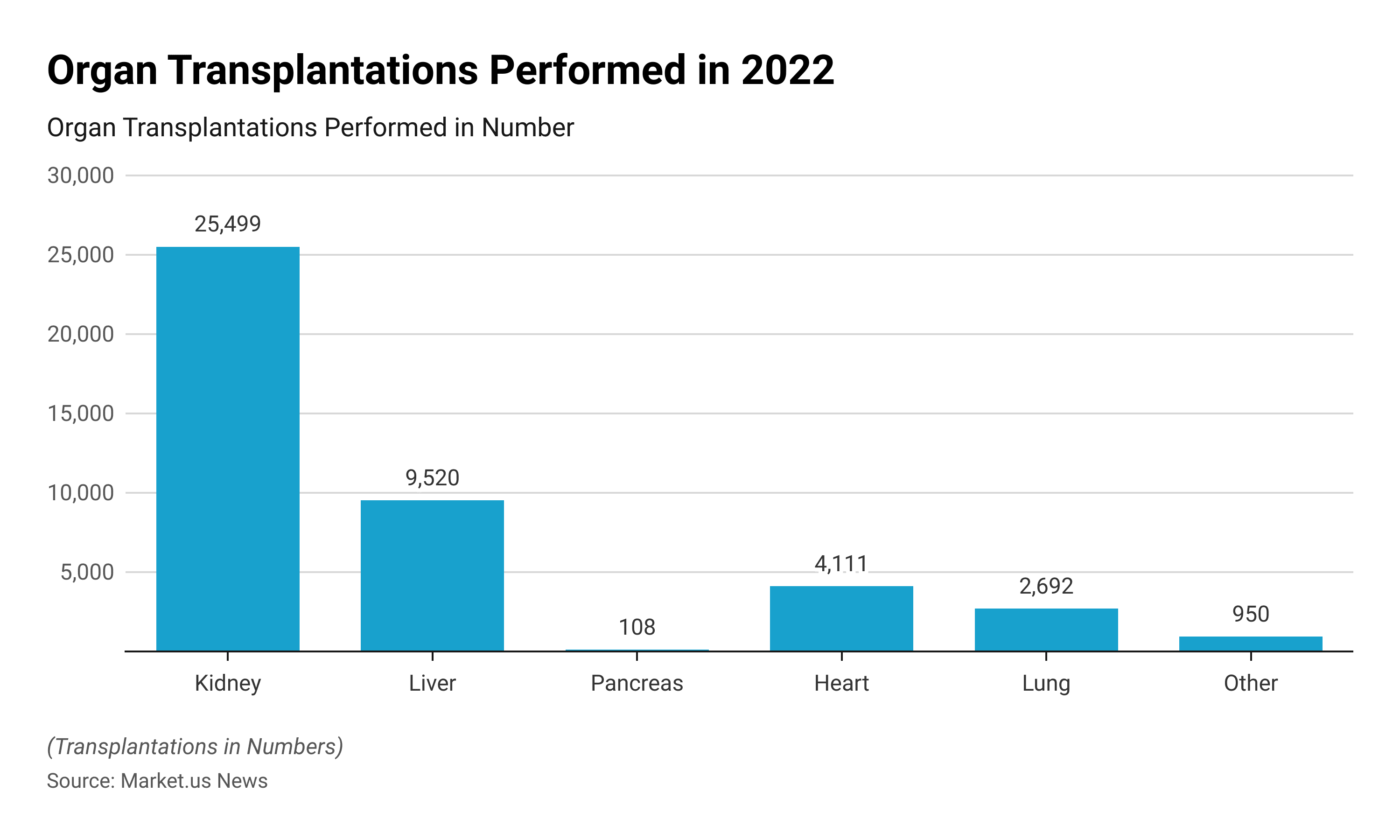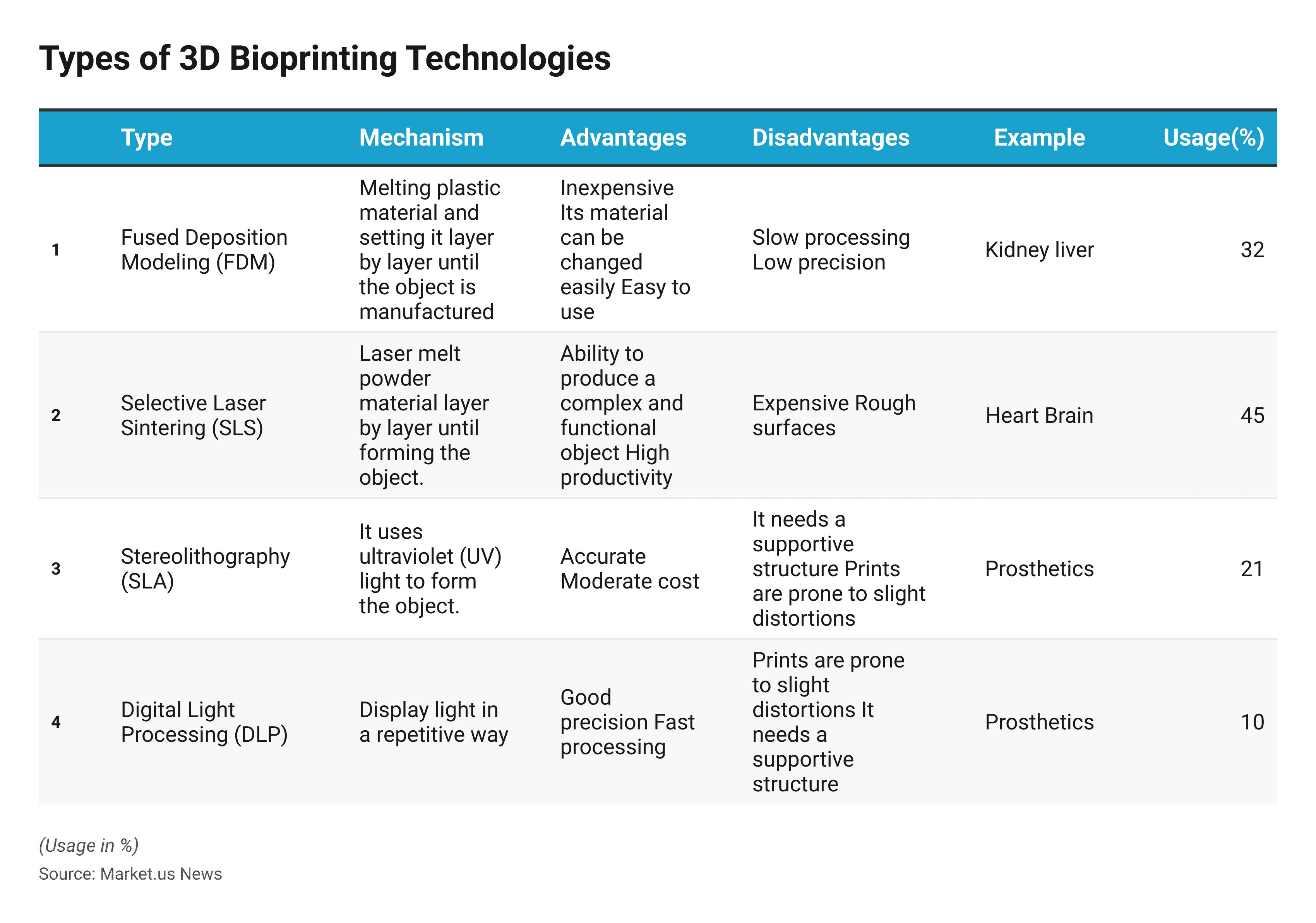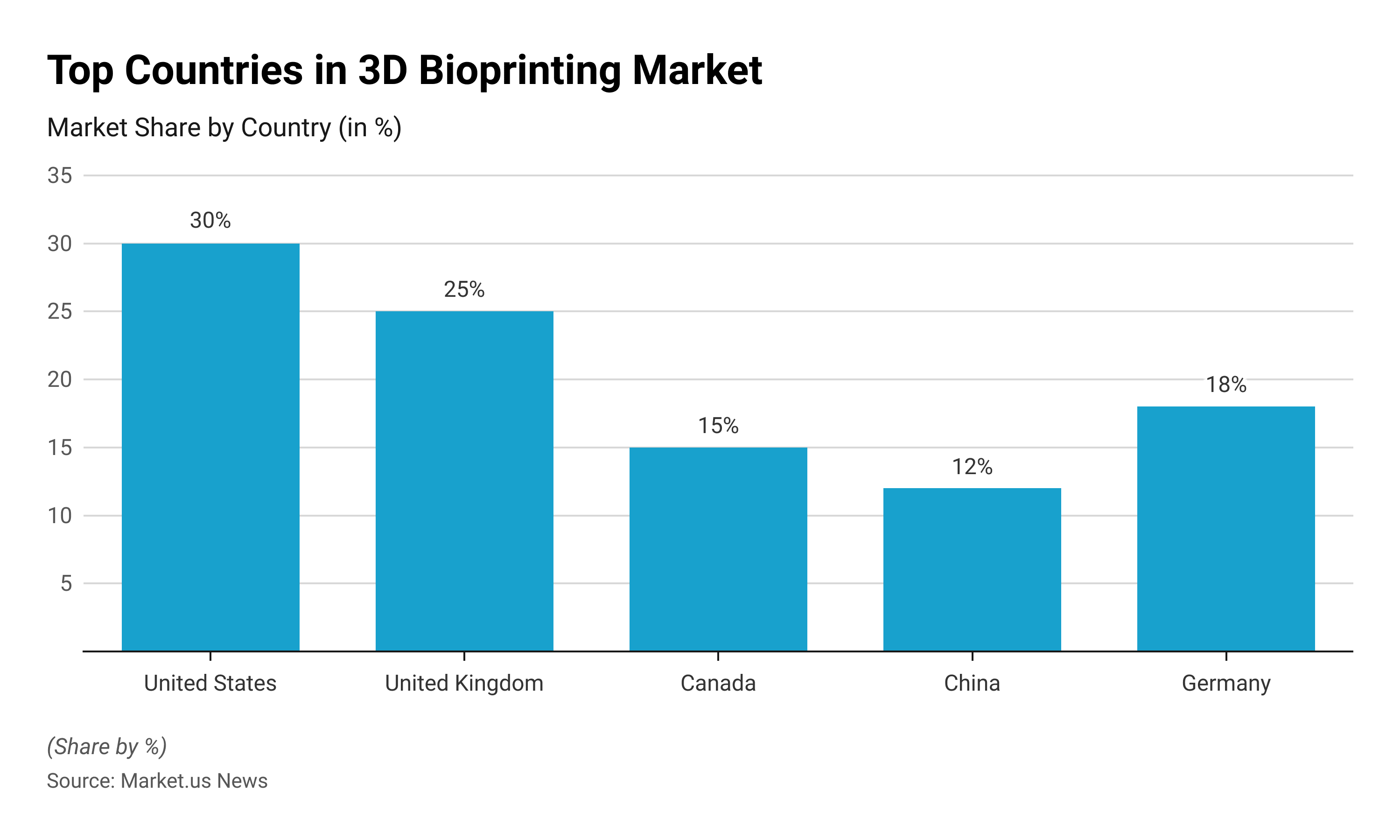3D Bioprinting Statistics: 3D bioprinting is an advanced manufacturing technique that combines principles from 3D printing technology with the field of tissue engineering.
This involves layer-by-layer deposition of living cells, biomaterials, and growth factors to fabricate three-dimensional structures that mimic the architecture and functionality of native tissues and organs.
Table of Contents
- Importance of 3D Bioprinting
- Editor’s Choice
- 3D Bioprinting Statistics – Applications
- 3D Bioprinting Statistics – Drug Discovery and Development
- 3D Bioprinting Statistics – Organ Transplantation and Transplantation Model
- Disease Modeling and Personalized Medicines
- Types of 3D Bioprinting Technologies
- Research Projects and Collaborations
- 3D Bioprinting Statistics – Top 3D Bioprinting Start-ups
- 3D Bioprinting Statistics – By Country
- Recent Developments
- Final Words
- FAQs
Importance of 3D Bioprinting
3D bioprinting has the potential to overcome the shortage of organ donors by enabling the fabrication of functional tissues and organs.
This technology can offer new treatment options for patients with organ failure, eliminating the need for lengthy organ transplant waiting lists and reducing the risks of organ rejection.
3D Bioprinting Statistics – Key Facts
One of the notable early successes in the adoption of 3D bioprinting occurred in 2006 when a team of scientists at Wake Forest Institute for Regenerative Medicine, led by Dr. Anthony Atala, successfully printed and implanted the first engineered organ, a bladder, into a patient.

Editor’s Choice
- The global 3D bioprinting market size is expected to be worth around USD 6.9 billion by 2032 from USD 1.6 billion in 2022, growing at a CAGR of 16.1% during the forecast period from 2022 to 2032.
- Based on technology, the 3D bioprinting market is segmented into magnetic levitation bioprinting, laser-assisted bioprinting, and inkjet-based bioprinting. Inkjet-based bioprinting segment accounts for the largest share of revenue at 39.0% in 2022.
- North America dominated the 3D bioprinting market with the largest revenue share of 36.4% in 2022.
- In Asia Pacific, this market accounts for 28.0% of the revenue share of the 3D bioprinting industry in 2022 and is anticipated to maintain its dominance over the forecast period.
- The bioprinting of human organs and tissues is a rapidly advancing field. As of 2021, several organs and tissues have been successfully printed, including liver tissue, kidney tissue, heart tissue, skin, and blood vessels.
- The field of 3D bioprinting has seen increased investments and funding. In 2020, the US National Institute of Health announced a USD 6.5 million investment to establish a 3D printed tissue manufacturing program.
(Source: Advanced Materials, NIH, market.us)
3D Bioprinting Statistics – Applications
Tissue engineering and regenerative medicine
3D bioprinting has revolutionized tissue engineering and regenerative medicine by providing promising approaches to creating complex, functional, and living tissues.
3D bioprinting enables the fabrication of tissue constructed by depositing cells and biomaterials in a controlled manner. One of the major challenges in tissue engineering is the formation of functional blood vessels to supply nutrients and oxygen to the newly formed tissues.
3D bioprinting techniques can be utilized to create vascular networks within engineered tissue, enabling the integration of vascularized constructs into the body for enhanced functionality and viability.
- The global tissue engineering market size is expected to be worth around USD 35 Bn by 2032 from USD 12 Bn in 2022, growing at a CAGR of 11.45% during the forecast period from 2023 to 2032.
- According to the World Health Organization, automobile accidents cause injuries that can be sustained by 20 to 50 million people each year. Tissue engineering is an alternative to surgical reconstruction and mechanical device instruction to restore injured tissues.
- In 2022, the tissue engineering market’s largest revenue share was held by North America.
- The American Cancer Society estimates that chronic lymphocytic leukemia (CLL) will account for 4,410 deaths in the previous year, driving market revenue growth in the United States.
- Around 420 people died while waiting for a transplant, according to NHS Blood and Transplant, and 7,000 people in the UK are on the transplant waiting list.
- There are about a total of 49 tissue engineering companies operating in the United States, out of them 29 were in commercial phase development and had tissue-engineered products available for sale.
- The 21 companies with tissue-engineered products on the market generated USD 9 billion in sales in 2022.
(Source: market.us, NIH)
3D Bioprinting Statistics – Drug Discovery and Development
3D bioprinting is a cutting-edge technology that holds significant potential for revolutionizing the field of drug discovery and development.
This 3D bioprinting allows the creation of complex tissue models that closely resemble human tissues and organs affected by diseases. Also, 3D bioprinting plays an important role in combining with microfluidics technology to create organ-on-a-chip platforms.
This platform stimulates the functions and interactions of multiple organs within a body, providing a realistic and interconnected model for drug testing.
- 3D bioprinting in drug testing and screening was valued at USD 580 million in 2020 and it is projected to reach a revenue of USD 1.9 billion by 2027.
- The organ-on-chip market depends on 3D bioprinting technology, which was valued at USD 18.8 million in 2020 and is driving at a CAGR of 37.6% from 2021-2028.
(Source: Statista)
3D Bioprinting Statistics – Organ Transplantation and Transplantation Model
3D bioprinting has emerged as a promising technology with the potential to revolutionize organ transplantation and transplantation models. One of the most significant applications of 3D bioprinting is the fabrication of organs for transplantation.
Using patient’s specific data, such as medical image scans, 3D bioprinters can create complex three-dimensional structures using bio-inks, which are compatible materials containing living cells.
- There are currently 121,678 people waiting for lifesaving organ transplants in the United States, out of them about 100,791 await kidney transplants.
- There are about 42,000 organ transplants were performed in 2022.
- In 2022, there were about 25,499 kidney transplants performed followed by transplants of liver about 9,528.
(Source: National Kidney Foundation, organ-donor)

Disease Modeling and Personalized Medicines
3D bioprinting allows researchers to create complex and realistic models of human organs and tissues, providing a powerful tool for studying diseases. Every individual is unique and their drug response can vary significantly.
With 3D bioprinting, it is possible to create personalized tissue constructs using patients’ cells. It enables the testing of drugs on a patient’s specific tissues, providing valuable information about the most effective treatment options and reducing the risks of adverse reactions.
- According to market.us, the global precision medicine market accounted for a revenue of USD 83.4 billion in 2022, and the market is expected to reach a revenue of USD 254 billion by 2032.
- Globally, biopharmaceutical companies spend USD 179 billion on R&D, according to the Pharmaceutical Industry and Global Health 2021 report, compared to the rest of the high-tech industry.
Types of 3D Bioprinting Technologies

Research Projects and Collaborations
- “Tissue Chip” Program (National Institutes of Health, USA): Tissue Chip and Drug Screening program, which aims to develop 3D bioprinted tissue models that mimic human organs. This collaborative initiative involves multiple research institutions and pharmaceutical companies to create functional organ chips for drug testing and toxicity screening.
- European Union-funded Projects: The European Union has funded various research projects focused on 3D bioprinting. For instance, the “Hybrid” project aims to develop a hybrid bioprinting technology by combining different bioprinting methods to create complex tissue constructs. The “INKREDIBLE+” project focuses on developing innovative bio-inks for bioprinting applications.
- Wyss Institute’s 3D Organ Engineering Initiative (Harvard University, USA): The Wyss Institute collaborates with multiple academic and industry partners to advance 3D bioprinting technology.
- Advanced Regenerative Manufacturing Institute (ARMI), USA: ARMI is a public-private partnership that brings together academic institutions, industry partners, and government agencies.
3D Bioprinting Statistics – Top 3D Bioprinting Start-ups
CELLINK
- Cellink is a bioprinting company that specializes in the development and commercialization of 3D bioprinters, bioinks, and other bioprinting-related products.
- Cellink offers a range of bioprinting systems, bio-inks, and other consumables that cater to various tissue engineering applications. The company offers extrusion-based bioprinters such as BIO X™, BIO X6™, and INKREDIBLE+™
- The company has raised funding of USD 100 million in 2022 for research and development of 3D bioprinting technologies.
- European Union, Sahlgrenska Science Park, and GU Ventures are the investors in the company.
(Source: tracxn)
Aspect Biosystems
- Aspect Biosystems is a biotechnology company based in Vancouver, Canada. The company specializes in the development of 3D bioprinting technologies and systems for applications in tissue engineering, drug discovery, and regenerative medicine.
- The company offers RX1 Bioprinting Platform and HistoMESH Technology for creating highly organized and functional 3D tissue structures.
- Aspect Biosystems estimated annual revenue is currently $14.4M per year.
- The total funding of Aspects Biosystems for 3D bioprinting research was USD 30 million in 2022.
(Source: tracxn)
Organovo Holdings Inc.
- Organovo Holdings Inc. is a biotechnology company that was founded in 2007 and based in San Diego, California. The company specializes in the development and commercialization of 3D bioprinting technology, which is used to create functional human tissues for medical research and applications.
- The company offers the NovoGen Bioprinter® Platform.
- In 2022 the total funding of Organovo Holdings Inc. was USD 13 million.
(Source: tracxn)
Inventia Life Sciences Pty Ltd.
- Inventia Life Sciences Pty Ltd. is an Australian company specializing in biomedical engineering and advanced 3D bioprinting technologies. The company was founded in 2013 and is headquartered in Sydney, Australia.
- The company offers the RASTRUM™ platform, which is an all-in-one platform that makes planning, creation, and analysis of your advanced cell models easy.
- The total funding of the company was USD 50 million in 2022.
(Source: tracxn)
Allevi Inc.
- Allevi Inc. is a company that specializes in bioprinting technology. The company develops and manufactures 3D bioprinters and related products for biomedical research and regenerative medicine fields.
- Allevi offers a range of bioprinters with different capabilities, including the Allevi 1, Allevi 2, Allevi 3, and Allevi 6.
- The total funding of Allevi Inc. in 2022 was USD 2 million.
(Source: tracing)
3D Bioprinting Statistics – By Country
- The United States: 3D bioprinting has gained significant attention in the United States. Several companies, research institutes, and universities in the US are actively involved in advancing the field of 3D bioprinting and its applications in regenerative medicine. The United States accounted for a market share of 30% in the 3D bioprinting market.
- United Kingdom: 3D bioprinting is an emerging field in the United States that holds a market share of 25%. The UK is focusing on advancing biomedical research and regenerative medicines. The universities in the UK such as Manchester, have a strong focus on bioprinting and tissue engineering.
- Canada: Canada is actively involved in research and development in the field of bioprinting, with a market share of about 15%. Several universities in Canada such as Toronto, the University of Ottawa, and Western University have a strong focus on regenerative medicine and tissue engineering.
- China: Several Chinese universities, research institutes, and companies are actively involved in bioprinting research and development. For example, the Institute of Biomedical Manufacturing and Life Quality Engineering at Shanghai Jiao Tong University has been conducting research on bioprinting and tissue engineering.
Market Share of Top Countries in the 3D Bioprinting Market

Recent Developments
Acquisitions and Mergers:
- BioTech Solutions acquired BioPrint Innovations for $300 million, expanding its presence in the 3D bioprinting market and integrating innovative bioprinting technologies into its portfolio.
- BiomedicalTech merged with OrganBio, forming a strategic partnership to advance 3D bioprinting research and develop personalized tissue engineering solutions, with combined annual revenues projected to exceed $500 million.
New Product Launches:
- BioPrintTech introduced a next-generation 3D bioprinter capable of printing complex tissue structures with enhanced precision, aiming to be utilized in 100 research institutions within the first year.
- TissueGen launched a biocompatible bioink for 3D bioprinting applications, enabling the fabrication of functional tissues and organs, targeting 50 research collaborations within six months.
Funding Rounds:
- BioPrint received $50 million in Series A funding led by Healthcare Investment Group XYZ to scale up their 3D bioprinting platform and invest in bioink development for clinical applications, aiming for a 50% increase in research partnerships within the next year.
- OrganTech secured $30 million in seed funding from Tech Investors ABC to advance tissue engineering research and develop 3D bioprinted implants for regenerative medicine, targeting a 40% growth in revenue over the next fiscal year.
Research Collaborations:
- Collaboration between academic institutions and biotech companies surged, with a 50% increase in research partnerships focused on 3D bioprinting applications for tissue engineering and regenerative medicine.
- Government funding for 3D bioprinting research projects doubled compared to the previous year, with $100 million allocated globally for initiatives aimed at advancing bioprinting technology and applications.
Regulatory Landscape:
- Regulatory agencies implemented guidelines for bioprinted tissue products and bioink materials, ensuring adherence to safety and quality standards in 3D bioprinting applications.
Investment in Research and Development:
- Biotechnology firms and research institutions allocated substantial resources to research and development in 3D bioprinting technology, with an estimated $1 billion invested globally in bioprinting advancements and market expansion initiatives.
Final Words
3D Bioprinting is a rapidly advancing field that holds great promise for the future of medicine and tissue engineering.
Researchers and companies across the globe including Germany are actively involved in developing 3D bioprinting techniques, bio-inks, and bioprinters.
As the 3D bioprinting field is continuously progressing, it holds promise for advancing healthcare and addressing the challenges associated with organ transplantation and tissue regeneration.
FAQs
3D bioprinting is a technology that uses specialized 3D printers to create three-dimensional structures composed of living cells, biomaterials, and other biological components. It allows the precise deposition of these materials in a layer-by-layer manner to create functional tissues and organ-like structures.
Bio inks are a key component in 3D bioprinting. They are specialized materials that serve as the “ink” for printing cells and biomaterials. Bioinks can be composed of natural or synthetic polymers, hydrogels, or decellularized extracellular matrix (ECM) materials. Bioinks provide structural support and a suitable microenvironment for cells to grow and differentiate within the printed structure.
As with any emerging technology, there are ethical considerations surrounding 3D bioprinting. Some key areas of concern include the sourcing of cells and biomaterials, potential exploitation of biological resources, equitable access to bio-printed tissues and organs, and ensuring the technology is used responsibly and with proper oversight.
Discuss your needs with our analyst
Please share your requirements with more details so our analyst can check if they can solve your problem(s)



